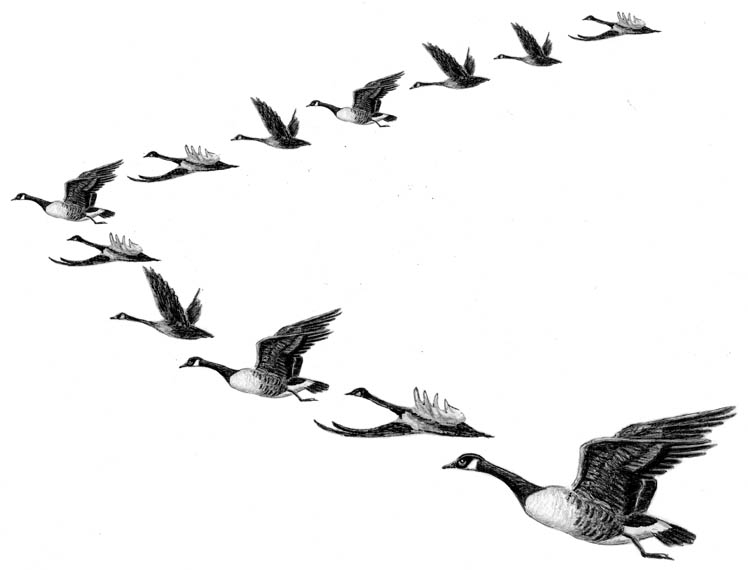
Dear Birds Folks,
I heard you on the radio the other day and I think you were discussing the reasons why geese fly in V-shaped flocks. Unfortunately, I couldn’t quite understand what you were saying. Would you mind explaining it again in print?
– Todd, Provincetown, MA
It’s not your fault, Todd,
Like most things in life, some days are better than others. On my weekly Talkin’ Birds radio segment, I was hoping to enlighten the world on why geese fly in those iconic Vs, but my mouth decided to take the morning off. For whatever reason, I couldn’t seem to form any coherent sentences. My intent was to make this avian phenomenon easy to understand, but I left a lot of folks scratching their heads. It was like reading an IKEA assembly manual. Nothing made sense. Here’s what I was trying to say.
This time of year flocks of Canada Geese routinely fly over my shop and land in the Orleans Town Cove across the street. As we all know, geese habitually travel in classic V-formations. This got me wondering: why do geese need to be so organized? Does it help them avoid predators? Does it keep them from smacking into each other? Does it save energy? Or are they just trying to look cool? I decided to look it up. I soon discovered that other folks were also wondering about this question. In fact, a few years ago several researchers studied this very topic and the answer is something that NASCAR followers already know about. Really.
Racing fans are familiar with the art of drafting, when one car rides just behind another. The front vehicle helps break the wind and create a slipstream, which actually benefits the trailing cars. To a lesser extent, a similar process is applied to cycling and speed skating. Skaters follow close behind the leader, making the leader do much of the work. The U.S. Air Force is well aware of this energy-saving technique and has been working hard to design planes and devise flight formations that will allow for “vortex surfing.” I’ll explain. As a plane flies through the air, its wings produce a downdraft (that’s bad), but eventually the air turns upward again, creating an updraft (that’s good). If a trailing plane can fly in these updrafts, it will save fuel. The problem is, staying in this updraft isn’t easy to do. A specific autopilot system had to be created to make it all work. Meanwhile, the lowly Canada Goose has been vortex surfing for centuries and has been doing it without special training or an expensive autopilot, or without paying taxes. (I’m not sure what that “tax” line has to do with this, but you probably can tell what I’ve been working on lately.)
When a goose flock migrates, the trailing birds fly just to the left or to the right of the lead bird (but never directly behind it, because we all know what comes out of the back of a goose). As the birds fall into place, each one finds its own optimum flying position and thus unintentionally creates the classic V-shape. It’s important to point out that this isn’t unique to geese. Swans, ibis, cranes, pelicans and other similar birds also do their share of vortex surfing. It has been assumed that the birds saved energy by flying this way, but unlike measuring fuel efficiency on an airplane, it was impossible to prove…at least until now.
A number of years ago, researchers put heart monitors on a flock of pelicans. This allowed the scientists to verify that the birds flying in back indeed had lower heart rates than the ones in front. Then, a few years later, other researchers put more sophisticated monitors on a flock of ibis. The ibis study not only supported the energy efficiency theory, but also proved that the birds’ position in the back wasn’t just random. Like the autopilot on the Air Force plane, the birds sought the most economical location behind the leader. But unlike planes, birds don’t have fixed wings; they need to flap in order to stay aloft. In addition to finding the best spot, the trailing birds also had to time their flapping to take advantage of the updraft. And if the bird somehow got out of synch, it would either have to flap faster or slower to get back on track. It’s like when we clap along to a song and then suddenly realize everyone else is clapping at a different tempo. We quickly have to do a couple of half-claps to get back on track. (Come on, don’t act like you don’t know. We’ve all done it.)
Right now you might be wondering: if this flying in formation is so beneficial, why don’t all birds do it? After all, we never see cardinals flying in a V. I think size is an issue. Smaller birds likely don’t create enough beneficial updraft. Scientists have also proved that the birds regularly change position, so no one lead bird has to carry the entire load. Although I’m not sure how the birds decide which one takes the lead first. Maybe they just call it out, like we did when we were kids going for a ride in the car and we’d yell, “Window!” We would also sometimes yell, “Shotgun!” but I doubt geese ever do that. They have issues with that word.
I hope my explanation was easier to understand this time, Todd. I don’t know what went wrong on the radio last week. No one was able to understand me that day. But as bad is it was, I was still clearer than an IKEA assembly manual. Even an Enigma machine can’t figure out one of those.